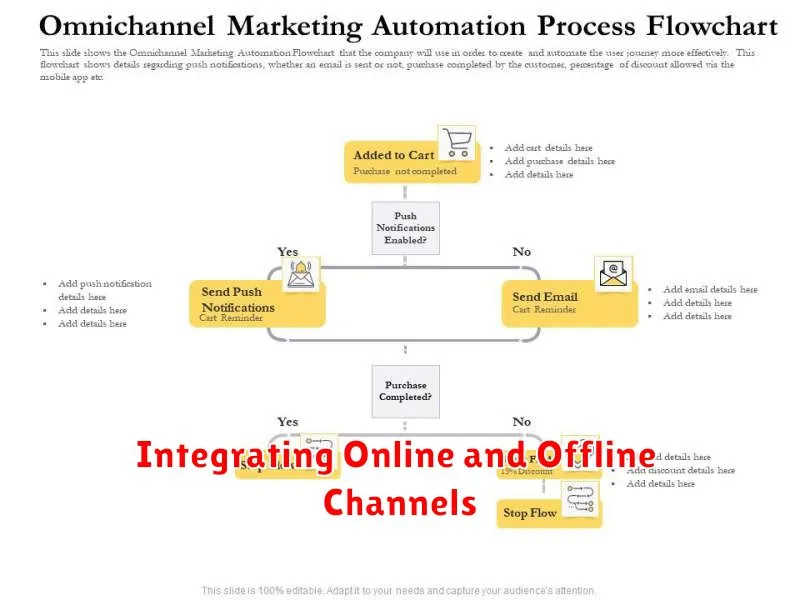In today’s interconnected world, customers interact with businesses across a multitude of touchpoints. A cohesive and effective omnichannel marketing strategy is no longer a luxury, but a necessity for businesses looking to thrive. This approach goes beyond simply being present on multiple channels; it’s about creating a seamless and personalized customer experience, regardless of whether they’re browsing your website, engaging on social media, visiting your physical store, or contacting customer support. Building a successful omnichannel marketing strategy requires careful planning, integration, and execution across all channels to deliver a unified brand message and experience.
This article will provide a comprehensive guide on how to build a powerful omnichannel marketing strategy. We’ll delve into the key components, from understanding your target audience and choosing the right channels to leveraging data and measuring your success. By implementing the strategies outlined here, you can enhance customer engagement, drive conversions, and foster long-term loyalty, ultimately boosting your business growth. Learn how to harness the power of omnichannel marketing to connect with your customers on a deeper level and achieve your business objectives.
Omnichannel vs Multichannel: Key Differences
While both omnichannel and multichannel approaches involve interacting with customers across multiple touchpoints, they differ significantly in their core strategy. Multichannel simply means using various independent channels like email, social media, and physical stores. Each channel operates in silos, with limited or no integration. Customers experience fragmented interactions, as their data and journey are not unified across channels.
Omnichannel, on the other hand, prioritizes a seamless and integrated customer experience. It connects all channels, enabling customers to transition smoothly between them. Information, like browsing history and past purchases, is shared across channels, creating a unified view of the customer. This allows for personalized messaging and a consistent brand experience regardless of how the customer chooses to interact.
Essentially, multichannel offers customers multiple touchpoints, while omnichannel provides a single, unified experience across those touchpoints. Omnichannel emphasizes the customer journey, ensuring consistency and personalization at every stage. Multichannel, in contrast, focuses on channel availability, not necessarily cohesion.
Why Omnichannel Improves Customer Experience
Omnichannel strategies significantly enhance customer experience by providing a seamless and integrated journey across all touchpoints. Customers can effortlessly switch between channels like online stores, mobile apps, social media, and physical locations while maintaining a consistent brand experience. This unified approach eliminates friction, allowing customers to start an interaction on one channel and seamlessly continue it on another without having to repeat information or restart the process. This ultimately fosters a sense of convenience and personalization that strengthens customer loyalty.
By gathering and analyzing data from various touchpoints, businesses gain valuable insights into customer behavior and preferences. This data-driven approach enables companies to personalize interactions, offer targeted promotions, and proactively address customer needs. For instance, a customer browsing products on a mobile app can receive personalized recommendations based on their past purchases and browsing history. This level of personalization fosters a stronger connection with the brand and increases customer satisfaction.
An effective omnichannel strategy fosters improved communication and builds stronger customer relationships. Customers can choose their preferred channel for communication, whether it’s email, live chat, social media, or phone. Consistent messaging across these channels ensures clarity and reinforces the brand’s identity. Furthermore, omnichannel enables businesses to provide proactive customer support by anticipating needs and resolving issues efficiently, ultimately leading to increased customer retention and advocacy.
Mapping the Customer Journey
Mapping the customer journey is a critical process for businesses seeking to understand how customers interact with their brand. It involves visually plotting every touchpoint a customer has with a company, from initial awareness to post-purchase engagement. This map provides valuable insights into customer behavior, pain points, and opportunities to improve the overall customer experience.
A well-defined customer journey map typically includes several key stages. These stages often include awareness (how the customer first learns about the brand), consideration (evaluating the brand against competitors), decision/purchase (making the purchase), and post-purchase (ongoing interactions and support). By analyzing each stage, businesses can identify areas for improvement, such as streamlining the checkout process, providing better customer service, or developing more targeted marketing campaigns.
Ultimately, the goal of customer journey mapping is to create a more seamless and positive experience for customers. By understanding the customer’s perspective and identifying areas of friction, businesses can optimize their processes and create a more customer-centric approach that fosters loyalty and drives growth.
Integrating Online and Offline Channels

Integrating online and offline channels is crucial for creating a seamless and consistent customer experience. By connecting the digital and physical realms, businesses can strengthen brand perception, gather valuable customer data, and ultimately drive increased sales. This omnichannel approach allows customers to interact with a brand on their preferred platform, whether it’s browsing products online, visiting a physical store, or contacting customer service. A key component of successful integration is ensuring data synchronization across all channels, allowing for personalized interactions and targeted marketing efforts.
Effective integration strategies can include offering options like “buy online, pick up in store” (BOPIS), providing consistent branding and messaging across all platforms, and using online data to inform offline strategies. For instance, understanding online browsing behavior can help tailor product displays in physical stores. Similarly, offering exclusive in-store promotions can drive traffic to brick-and-mortar locations. By creating a unified brand experience, businesses can foster customer loyalty and increase engagement.
Ultimately, the goal of channel integration is to create a customer-centric approach that prioritizes convenience and personalization. By leveraging both online and offline channels effectively, businesses can reach a wider audience, enhance customer satisfaction, and drive sustainable growth. It’s important to continuously analyze data and customer feedback to optimize strategies and ensure the seamless integration remains effective and relevant.
Choosing Tools for Seamless Experience
Selecting the right tools is crucial for a seamless experience. Whether you’re building a software application, assembling furniture, or cooking a meal, the tools you use directly impact the efficiency and quality of the final product. Consider the specific requirements of the task. For complex projects, specialized tools might be necessary, while simpler tasks may only require basic tools. Evaluating tool quality is also essential. Durable and reliable tools ensure a smoother process and prevent frustrating setbacks.
Before choosing any tools, research different options and compare their features. Read reviews, watch demonstrations, and consider asking for recommendations from experienced individuals. A thoughtful selection process minimizes the chance of purchasing inadequate or unnecessary tools. Budget is another important factor. While professional-grade tools often offer superior performance, they also come with a higher price tag. Balance quality and affordability by choosing tools that meet your needs without exceeding your budget constraints.
Finally, consider the ergonomics and user-friendliness of the tools. Comfortable handles, intuitive controls, and well-balanced designs can significantly enhance the user experience. Tools that are difficult to use or cause discomfort can lead to errors and fatigue. Prioritizing ergonomics is essential, particularly for tasks that require extended periods of use.
Personalization Across Platforms
Cross-platform personalization delivers a unified and consistent user experience across multiple devices and touchpoints. This means recognizing and catering to individual user preferences whether they’re interacting through a website, mobile app, smart speaker, or any other connected device. By leveraging data from all these interactions, businesses can offer more relevant content, product recommendations, and targeted messaging, ultimately strengthening customer relationships and driving engagement.
Implementing effective cross-platform personalization requires a robust data strategy. This includes collecting and integrating user data from various sources, creating unified user profiles, and employing advanced analytics to understand individual behaviors and preferences. Data privacy and security are paramount, and businesses must ensure they are adhering to relevant regulations and respecting user consent when collecting and utilizing personal information. Successfully managing this data allows for a seamless and personalized experience, no matter how a customer chooses to engage.
The benefits of successful cross-platform personalization are significant. Increased customer satisfaction, improved conversion rates, and enhanced brand loyalty are just a few key advantages. By creating a consistent and personalized experience, businesses can foster stronger connections with their customers, leading to higher lifetime value and a competitive edge in the market.
Measuring Cross-Channel Engagement
Measuring cross-channel engagement involves tracking customer interactions across multiple touchpoints, both online and offline. This provides a holistic view of customer behavior, revealing how they interact with your brand across different channels like social media, email, your website, and physical stores. By analyzing this data, businesses can gain valuable insights into customer preferences, optimize their marketing strategies, and improve the overall customer experience. Key metrics often tracked include reach, engagement rate (likes, shares, comments), conversions (purchases, sign-ups), and customer lifetime value.
A key challenge in measuring cross-channel engagement is accurately attributing interactions to the correct channels. Customers may research a product online but ultimately make a purchase in-store, or vice versa. Implementing consistent tracking mechanisms across all channels, like unique identifiers and robust analytics platforms, is crucial for accurate measurement and analysis. This allows businesses to understand the customer journey and the influence of each channel on the final conversion.
Effective cross-channel measurement enables businesses to personalize customer interactions and improve marketing ROI. By understanding which channels are most effective at different stages of the customer journey, businesses can tailor their messaging and offers to resonate with individual customer needs and preferences. This leads to increased engagement, higher conversion rates, and stronger customer relationships.
Breaking Down Silos in Teams
Silos in teams occur when groups within an organization operate in isolation, hindering communication and collaboration. This can lead to duplicated efforts, conflicting goals, and a lack of overall synergy. Breaking down these silos is crucial for organizational success, fostering a more unified and productive work environment. Open communication is key, encouraging teams to share information and work together transparently. Regular cross-functional meetings, shared projects, and collaborative workspaces can facilitate this interaction.
Leadership plays a vital role in dismantling silos. Leaders need to actively promote a culture of collaboration and shared responsibility. This involves setting clear overarching goals that align individual teams towards a common purpose. Recognizing and rewarding cross-team collaboration reinforces the desired behavior. Additionally, providing opportunities for teams to learn about each other’s work and understand their respective challenges can build empathy and break down barriers.
Implementing collaborative tools and technologies can also help bridge the gap between teams. Shared platforms for project management, communication, and document storage facilitate easy access to information and streamline workflows. This enhanced transparency and connectivity helps break down informational silos and promotes a more integrated and efficient work environment.
Examples of Omnichannel Success
Sephora is a prime example of omnichannel retail done right. They seamlessly blend their online and offline experiences. For example, customers can book in-store makeovers online, check product availability in local stores, and even use augmented reality in their app to virtually “try on” makeup. This integration creates a personalized and convenient experience that boosts customer engagement and loyalty.
Bank of America leverages omnichannel strategies to provide flexible banking options. Customers can access their accounts, transfer funds, deposit checks, and contact customer support through various channels including their website, mobile app, ATMs, and physical branches. This integrated approach ensures customers can manage their finances however and whenever they prefer, resulting in increased customer satisfaction and retention.
Disney excels at creating an immersive omnichannel experience. From booking park tickets and hotel reservations online, to using the My Disney Experience app for ride reservations and mobile ordering, to interacting with characters in the park, Disney creates a cohesive and magical experience that extends beyond a single touchpoint. This interconnected approach fosters brand loyalty and encourages repeat visits.
Avoiding Fragmented Messaging

Fragmented messaging occurs when communication about a particular topic is spread across different channels, platforms, or teams, creating confusion and inefficiency. This lack of a unified message can lead to misunderstandings, diluted brand identity, and ultimately, a negative impact on goals. For example, if marketing promotes a product feature that customer service isn’t aware of, customers will be frustrated and lose trust in the company. Consistency is key to avoiding this pitfall.
To counteract fragmented messaging, it’s crucial to establish centralized communication strategies. This involves designating clear ownership for specific topics and creating a unified message platform. All teams involved should have access to the same information and be trained on delivering consistent messaging. Regular communication audits and feedback loops can help identify and address any discrepancies quickly.
A few key benefits of a cohesive communication strategy include a stronger brand identity, improved customer satisfaction, and increased operational efficiency. By ensuring everyone is on the same page, organizations can present a unified front, build trust with their audience, and ultimately achieve their strategic objectives.

